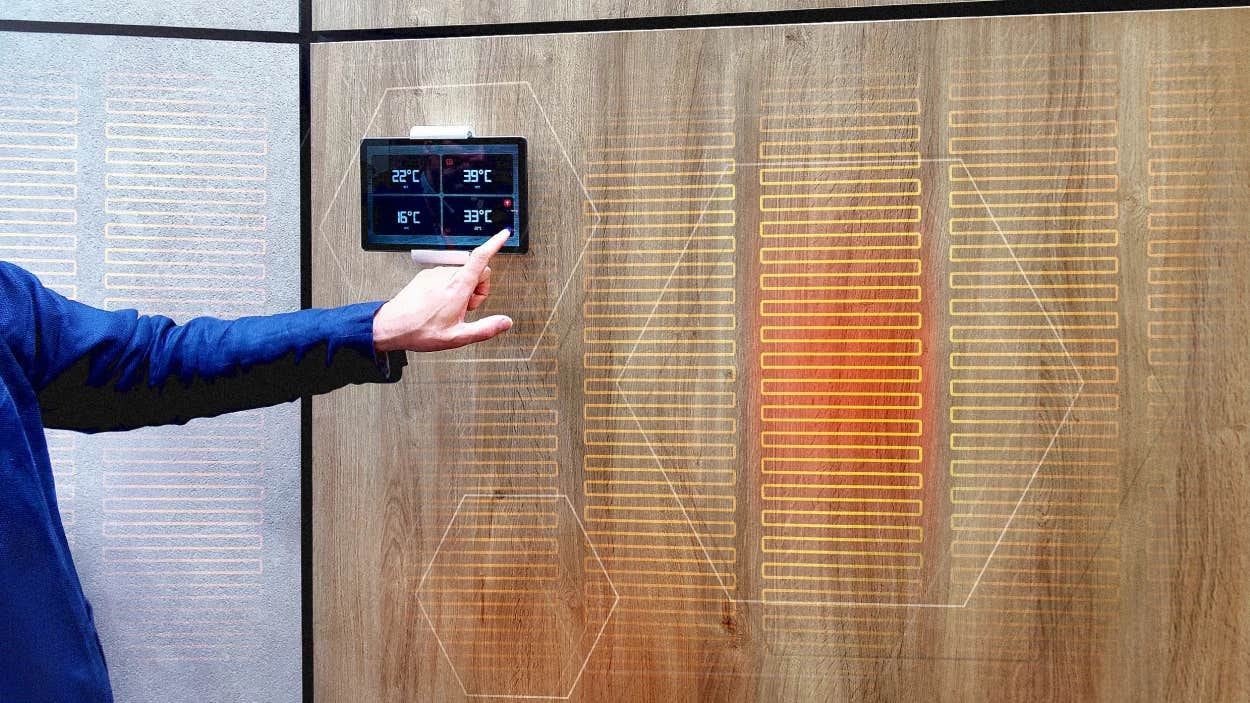Groundbreaking paper-thin laminate turns walls or furniture into an energy-efficient heater
A startup designed a thin metal mesh that’s hidden inside what looks like an ordinary piece of laminate that can heat a room in seconds

[June 27, 2023: Staff Writer, The Brighter Side of News]
A Finnish startup designed a thin metal mesh that’s hidden inside what looks like an ordinary piece of laminate. But it can heat a room within seconds. (CREDIT: Warming Surfaces Company)
This is no ordinary piece of laminate. The modest paneling found on most dressers, desks, and floors has been given a radical makeover, courtesy of a Finnish startup that has embedded a paper-thin metal mesh within it to turn your furniture or even walls into energy-efficient radiant heaters.
The Warming Surfaces Company, the ingenious firm behind the heating tech, dubbed "Halia," is the brainchild of a spin-off from Finland's government-owned R&D center, VTT. VTT engineers have been honing their expertise in the field of flexible printed electronics for over two decades, leading to the birth of this groundbreaking innovation.
Interestingly, the roots of this transformative technology can be traced back to a military context. The Finnish military, in need of heat-emitting decoys to dupe potential attackers, had approached VTT researchers for assistance. The aim was to create illusions of tanks and other equipment in the night through heat emissions from large surfaces.
In the process of creating this military subterfuge, the VTT researchers realized that the technology they were developing had much broader applications, including warming homes and offices.
Related Stories
"We started fitting this into furniture and interior surface materials and saw, wow, there's potential here," said Jani-Mikael Kuusisto, the co-founder of the Warming Surfaces Company, which officially launched last fall.
The unique low-voltage heating elements in Halia are less than one millimeter, or 1/25th of an inch thick, allowing them to be discreetly integrated into a wide array of materials, including fabric. These slender elements are strategically placed near the surface over large areas, enabling them to heat a room almost instantly.
Kuusisto explained the functionality of the technology, describing how each individual heat "pixel" is linked to a central processing unit that is connected to the grid or a battery for electric power. When connected to sensors, either embedded in the material or via a standard home automation system, the heat can be deployed only when required.
Finnish startup has embedded a paper-thin metal mesh within it to turn your furniture or even walls into energy-efficient radiant heaters. (CREDIT: Warming Surfaces Company)
"Your surroundings sense when you're in the room, or approaching, and it turns on the temperature to the level that you prefer," Kuusisto explained. "It's really a fast response. It's not immediate, like lighting, but we're talking tens of seconds to reach your desired temperature."
Aside from its remarkable speed and responsiveness, this heating technology also boasts a handful of other advantages over traditional systems. Like other forms of radiant heating, it can heat a space more uniformly than typical forced air systems, and without the added distraction of noisy blowing fans. And, unlike some heat pumps, it doesn't take up any space or become an eyesore on your wall.
Unlike some heat pumps, it doesn't take up any space or become an eyesore on your wall. (CREDIT: Warming Surfaces Company)
Warming Surfaces Company is currently collaborating with Surforma, a laminate manufacturer based in Portugal, and Grupo Casais, a construction company, to test new products incorporating this revolutionary technology. Kuusisto suggested that one of the initial applications is likely to be office furniture. There will also be construction pilots commencing this fall in Portugal.
"The manufacturing has been fully proven," he confirmed. "Now, it's a matter of scaling it to the needs of the furniture and construction-materials industry." Since the technology requires minimal material, it is expected to be cheaper to manufacture than other heating tech.
These slender elements are strategically placed near the surface over large areas, enabling them to heat a room almost instantly. (CREDIT: Warming Surfaces Company)
It also promises low installation costs as it can be directly incorporated into building materials or furniture. The pilot programs in Portugal will provide valuable data on operating cost and performance.
In regions with milder winters like Portugal, this technology could effectively maintain comfort in an office or room without the need for additional heating sources. The company aims to launch the first products equipped with this technology by 2024.
It also promises low installation costs as it can be directly incorporated into building materials or furniture. (CREDIT: Warming Surfaces Company)
Kuusisto has big hopes for the role of Halia in promoting more sustainable building practices. He pointed out that nearly two-thirds of energy used by European households is for heating. This new technology could significantly reduce the carbon footprint of buildings by providing a more energy-efficient method of heating.
As we look forward to a future increasingly concerned with energy efficiency and carbon reduction, the Warming Surfaces Company and their game-changing Halia technology could truly revolutionize how we think about heating our homes and workplaces.
For more green news stories check out our Green Impact section at The Brighter Side of News.
Note: Materials provided above by The Brighter Side of News. Content may be edited for style and length.
Like these kind of feel good stories? Get the Brighter Side of News' newsletter.
Joseph Shavit
Head Science News Writer | Communicating Innovation & Discovery
Based in Los Angeles, Joseph Shavit is an accomplished science journalist, head science news writer and co-founder at The Brighter Side of News, where he translates cutting-edge discoveries into compelling stories for a broad audience. With a strong background spanning science, business, product management, media leadership, and entrepreneurship, Joseph brings a unique perspective to science communication. His expertise allows him to uncover the intersection of technological advancements and market potential, shedding light on how groundbreaking research evolves into transformative products and industries.



